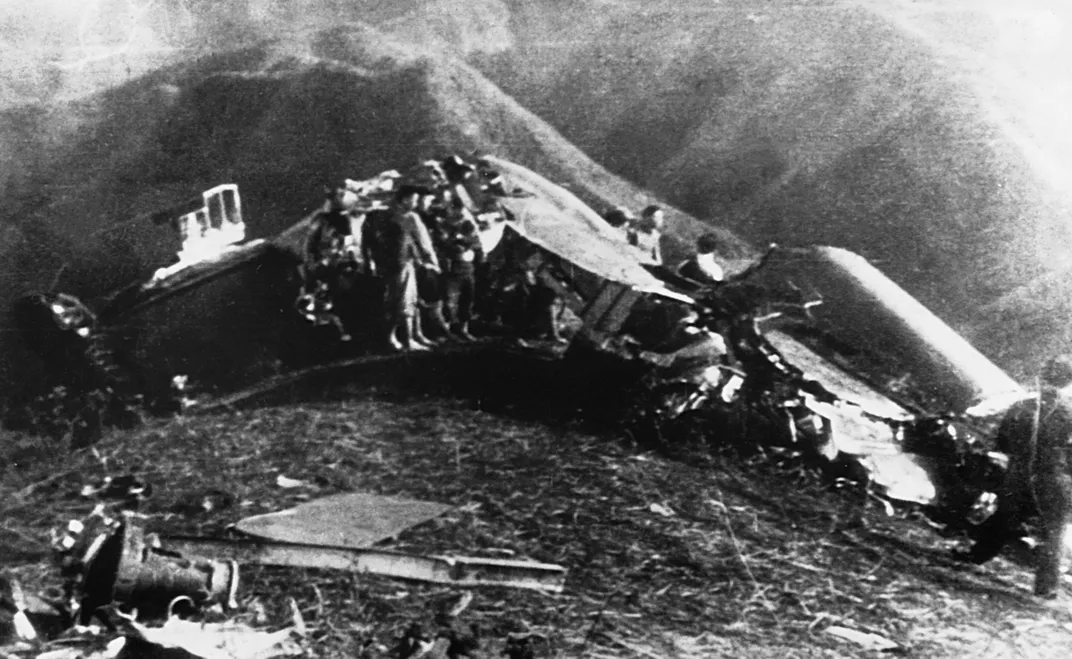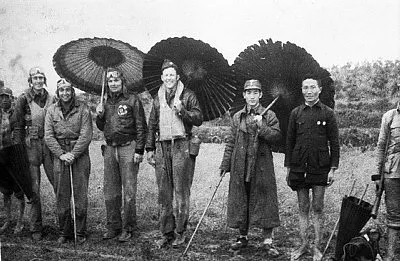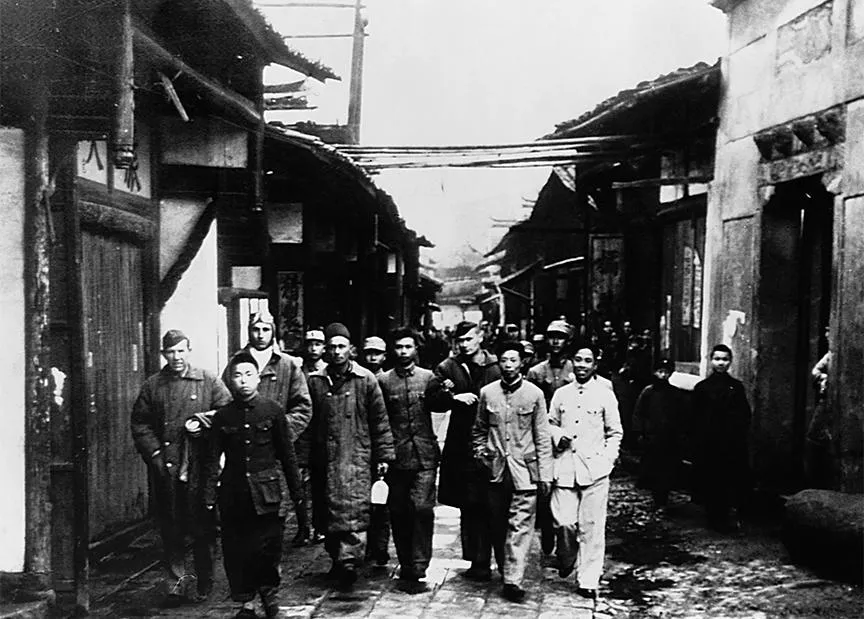The Untold Story of the Vengeful Japanese Attack After the Doolittle Raid
When the U.S. responded to Pearl Harbor with a surprise bombing of Tokyo, the Imperial Army took out its fury on the Chinese people
/https://tf-cmsv2-smithsonianmag-media.s3.amazonaws.com/filer/44/96/4496ecfa-b30c-4a81-a78d-b00f319a49da/planes.jpg)
At midday on April 18, 1942, 16 U.S. Army bombers, under the command of daredevil pilot Lt. Col. Jimmy Doolittle, thundered into the skies over Tokyo and other key Japanese industrial cities in a surprise raid designed to avenge the attack on Pearl Harbor. For the 80 volunteer raiders, who lifted off that morning from the carrier Hornet, the mission was one-way. After attacking Japan, most of the aircrews flew on to Free China, where low on fuel, the men either bailed out or crash-landed along the coast and were rescued by local villagers, guerrillas and missionaries.
That generosity shown by the Chinese would trigger a horrific retaliation by the Japanese that claimed an estimated quarter-million lives and would prompt comparisons to the 1937-38 Rape of Nanking. American military authorities, cognizant that a raid on Tokyo would result in a vicious counterattack upon free China, saw the mission through regardless, even keeping the operation a secret from their Pacific theater allies. This chapter of the Doolittle Raid has largely gone unreported—until now.
Long-forgotten missionary records discovered in the archives of DePaul University for the first time shed important new light on the extent to which the Chinese suffered in the aftermath of the Doolittle raid.
In the moments after the attack on Tokyo, Japanese leaders fumed over the raid, which had revealed China’s coastal provinces as a dangerous blind spot in the defense of the homeland. American aircraft carriers not only could launch surprise attacks from the seas and land safely in China but could possibly even fly bombers directly from Chinese airfields to attack Japan. The Japanese military ordered an immediate campaign against strategically important airfields, issuing an operational plan in late April, just days after the Doolittle raid.
Survivor accounts point to an ulterior objective: to punish the Chinese allies of the United States forces, especially those towns where the American aviators had bailed out after the raid. At the time, Japanese forces occupied Manchuria as well as key coastal ports, railways and industrial and commercial centers in China.
The United States had neither boots on the ground nor faith that the Chinese military could repel any farther advances by occupying Japanese forces. Details of the destruction that would soon follow—just as officials in Washington and Chungking, the provisional capital of China, and even Doolittle, had long predicted—would come from the records of American missionaries, some of whom had helped the raiders. The missionaries knew of the potential wrath of the Japanese, having lived under a tenuous peace in this border region just south of occupied China. Stories of the atrocities at Nanking, where the river had turned red from blood, had circulated widely. When the Japanese came into a town, “the first thing that you see is a group of cavalrymen,” Herbert Vandenberg, an American priest, would recall. “The horses have on shiny black boots. The men wear boots and a helmet. They are carrying sub-machine guns.”

Vandenberg had heard the news broadcasts of the Tokyo raid in the mission compound in the town of Linchwan, home to about 50,000 people, as well as to the largest Catholic church in southern China, with a capacity to serve as many as a thousand. Days after the raid letters reached Vandenberg from nearby missions in Poyang and Ihwang, informing him that local priests cared for some of the fliers. “They came to us on foot,” Vandenberg wrote. “They were tired and hungry. Their clothing was tattered and torn from climbing down the mountains after bailing out. We gave them fried chicken. We dressed their wounds and washed their clothes. The nuns baked cakes for the fliers. We gave them our beds.”
By early June, the devastation had begun. Father Wendelin Dunker observed the result of a Japanese attack on the town of Ihwang:
“They shot any man, woman, child, cow, hog, or just about anything that moved, They raped any woman from the ages of 10 – 65, and before burning the town they thoroughly looted it.”
He continued, writing in his unpublished memoir, “None of the humans shot were buried either, but were left to lay on the ground to rot, along with the hogs and cows.”
The Japanese marched into the walled city of Nancheng at dawn on the morning of June 11, beginning a reign of terror so horrendous that missionaries would later dub it “the Rape of Nancheng.” Soldiers rounded up 800 women and herded them into a storehouse outside the east gate. “For one month the Japanese remained in Nancheng, roaming the rubble-filled streets in loin clothes much of the time, drunk a good part of the time and always on the lookout for women,” wrote the Reverend Frederick McGuire. “The women and children who did not escape from Nancheng will long remember the Japanese—the women and girls because they were raped time after time by Japan’s imperial troops and are now ravaged by venereal disease, the children because they mourn their fathers who were slain in cold blood for the sake of the ‘new order’ in East Asia.”
At the end of the occupation, Japanese forces systematically destroyed the city of 50,000 residents. Teams stripped Nancheng of all radios, while others looted the hospitals of drugs and surgical instruments. Engineers not only wrecked the electrical plant but pulled up the railroad lines, shipping the iron out. A special incendiary squad started its operation on July 7 in the city’s southern section. “This planned burning was carried on for three days,” one Chinese newspaper reported, “and the city of Nancheng became charred earth.”
Over the summer, the Japanese laid waste to some 20,000 square miles. They looted towns and villages, then stole honey and scattered beehives. Soldiers devoured, drove away, or simply slaughtered thousands of oxen, pigs, and other farm animals; some wrecked vital irrigation systems and set crops on fire. They destroyed bridges, roads, and airfields.“Like a swarm of locusts, they left behind nothing but destruction and chaos,” Dunker wrote.

Those discovered to have helped the Doolittle raiders were tortured. In Nancheng, soldiers forced a group of men who had fed the airmen to eat feces before lining up ten of them for a “bullet contest” to see how many people a single bullet would pass through before it stopped. In Ihwang, Ma Eng-lin, who had welcomed injured pilot Harold Watson into his home, was wrapped in a blanket, tied to a chair and soaked in kerosene. Then soldiers forced his wife to torch him.
“Little did the Doolittle men realize,” the Reverend Charles Meeus later wrote, “that those same little gifts which they gave their rescuers in grateful acknowledgement of their hospitality— parachutes, gloves, nickels, dimes, cigarette packages—would, a few weeks later, become the telltale evidence of their presence and lead to the torture and death of their friends!”
A missionary with the United Church of Canada, the Reverend Bill Mitchell traveled in the region, organizing aid on behalf of the Church Committee on China Relief. Mitchell gathered statistics from local governments to provide a snapshot of the destruction. The Japanese flew 1,131 raids against Chuchow—Doolittle’s intended destination—killing 10,246 people and leaving another 27,456 destitute. They destroyed 62,146 homes, stole 7,620 head of cattle, and burned 30 percent of the crops.
“Out of twenty-eight market towns in that region,” the committee’s report noted, “only three escaped devastation.” The city of Yushan, with a population of 70,000 —many of whom had participated in a parade led by the mayor in honor of raiders Davy Jones and Hoss Wilder—saw 2,000 killed and 80 percent of the homes destroyed. “Yushan was once a large town filled with better-than-average houses. Now you can walk thru street after street seeing nothing but ruins,” Father Bill Stein wrote in a letter. “In some places you can go several miles without seeing a house that was not burnt.”
That August, Japan’s secret bacteriological warfare group, Unit 731, launched an operation to coincide with the withdrawal of Japanese troops from the region.
In what was known as land bacterial sabotage, troops would contaminate wells, rivers, and fields, hoping to sicken local villagers as well as the Chinese forces, which would no doubt move back in and reoccupy the border region as soon as the Japanese departed. Over the course of several meetings, Unit 731’s commanding officers debated the best bacteria to use, settling on plague, anthrax, cholera, typhoid, and paratyphoid, all of which would be spread via spray, fleas, and direct contamination of water sources. For the operation, almost 300 pounds of paratyphoid and anthrax germs were ordered.
Technicians filled peptone bottles with typhoid and paratyphoid bacteria, packaged them in boxes labeled “Water Supply,” and flew them to Nanking. Once in Nanking, workers transferred the bacteria to metal flasks—like those used for drinking water— and flew them into the target areas. Troops then tossed the flasks into wells, marshes, and homes. The Japanese also prepared 3,000 rolls, contaminated with typhoid and paratyphoid, and handed them to hungry Chinese prisoners of war, who were then released to go home and spread disease. Soldiers left another 400 biscuits infected with typhoid near fences, under trees, and around bivouac areas to make it appear as though retreating forces had left them behind, knowing hungry locals would devour them.

The region’s devastation made it difficult to tally who got sick and why, particularly since the Japanese had looted and burned hospitals and clinics. The thousands of rotting human and livestock carcasses that clogged wells and littered the rubble also contaminated the drinking water. Furthermore, the impoverished region, where villagers often defecated in holes outdoors, had been prone to such outbreaks before the invasion. Anecdotal evidence gathered from missionaries and journalists shows that many Chinese fell sick from malaria, dysentery, and cholera even before the Japanese reportedly began the operation.
Chinese journalist Yang Kang, who traveled the region for the Takung Pao newspaper, visited the village of Peipo in late July. “Those who returned to the village after the enemy had evacuated fell sick with no one spared,” she wrote. “This was the situation which took place not only in Peipo but everywhere.”
In December 1942, Tokyo radio reported massive outbreaks of cholera, and the following spring, the Chinese reported that a plague epidemic forced the government to quarantine the Chekiang town of Luangshuan. “The losses suffered by our people,” one later wrote, “were inestimable.” Some of Unit 731’s victims included Japanese soldiers. A lance corporal captured in 1944 told American interrogators that upward of 10,000 troops were infected during the Chekiang campaign.
“Diseases were particularly cholera, but also dysentery and pest,” an American intelligence report stated. “Victims were usually rushed to hospitals in rear, particularly the Hangchow Army Hospital, but cholera victims, usually being treated too late, mostly died.” The prisoner saw a report that listed 1,700 dead, most of cholera. Actual deaths likely were much higher, he said, “it being common practice to pare down unpleasant figures.”
The three-month campaign across Chekiang and Kiangsi Provinces infuriated many in the Chinese military, who understood it as a consequence of a U.S. raid designed to lift the spirits of Americans. Officials in Chungking and Washington had purposely withheld details of the U.S. raid from Chinese ruler Chiang Kai-shek, assuming the Japanese would retaliate.
“After they had been caught unawares by the falling of American bombs on Tokyo, Japanese troops attacked the coastal areas of China, where many of the American fliers had landed,” Chiang cabled to Washington. “These Japanese troops slaughtered every man, woman and child in those areas. Let me repeat—these Japanese troops slaughtered every man, woman and child in those areas.”
News trickled out in American media in the spring of 1943 as missionaries who witnessed the atrocities returned home. The New York Times editorialized, “The Japanese have chosen how they want to represent themselves to the world. We shall take them at their own valuation, on their own showing. We shall not forget, and we shall see that a penalty is paid.”
The Los Angeles Times was far more forceful:
To say that these slayings were motivated by cowardice as well as savagery is to say the obvious. The Nippon war lords have thus proved themselves to be made of the basest metal …
Those notices, however, did not get much traction, and the slaughter was soon forgotten. It was a tragedy best described by a Chinese journalist at the time. “The invaders made of a rich, flourishing country a human hell,” the reporter wrote, “a gruesome graveyard, where the only living thing we saw for miles was a skeleton-like dog, who fled in terror before our approach.”
Excerpted from Target Tokyo: Jimmy Doolittle and the Raid that Avenged Pearl Harbor by James M. Scott. Copyright © 2015 by James M. Scott. With permission of the publisher, W. W. Norton & Company, Inc. All rights reserved.
